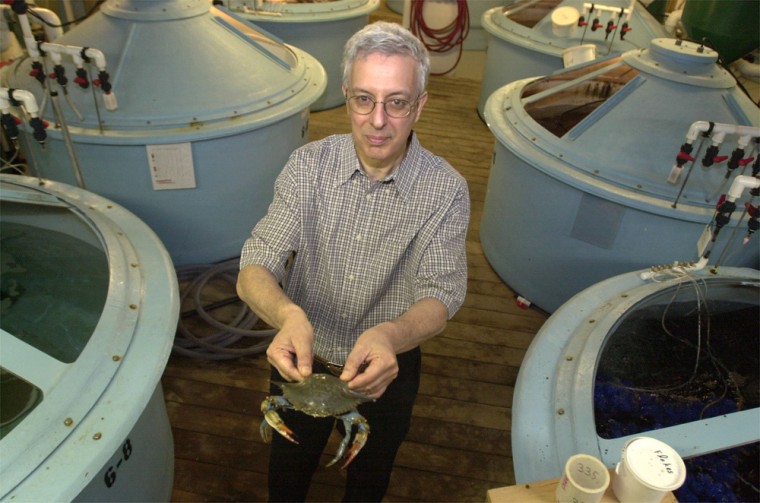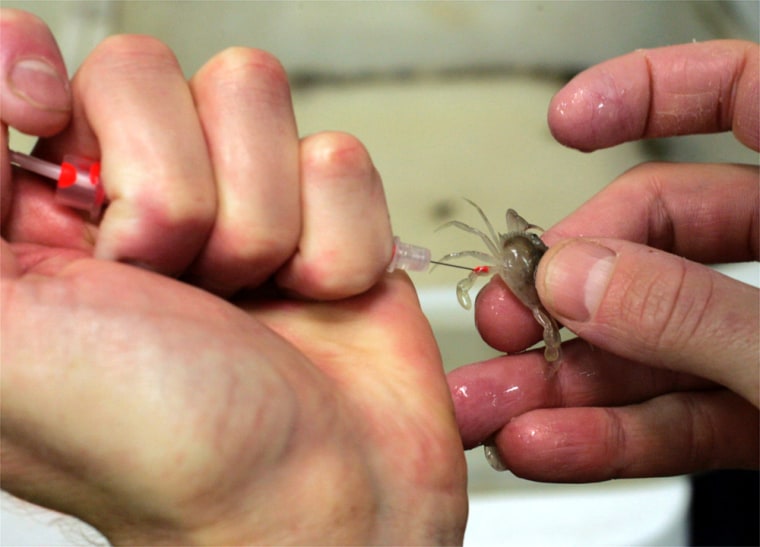More than 1,600 wriggling blue crabs, so young that their shells are still soft and see-through, are taken from gurgling tanks and dropped one at a time into coolers filled with nets. Minutes later, they are loaded onto trucks, driven to two tributaries of the Chesapeake Bay and dropped into the water.
The crab nursery at Piney Point represents a modest, experimental start to what scientists hope becomes something much bigger: a large-scale project to halt or reverse the sharp decline in the Chesapeake Bay population of blue crabs.
Blue crabs have long been a symbol of the bay’s abundance of seafood. In restaurants in Maryland and the Washington area, blue crabs are served as up crabcakes or steamed in spicy, lip-tingling Old Bay seasoning and dumped straight onto tables covered in brown paper, to be cracked open with wooden mallets.
“They’re a symbol of Maryland and the Chesapeake Bay, so it’s important that the crab be healthy and we look out for them,” said Larry Simns, president of the Maryland Watermen’s Association.
Hatching the crabs
To help the crab claw its way back, a federally funded consortium of universities and other institutions is hatching crabs at a laboratory in Baltimore’s Inner Harbor, raising them at Piney Point in tanks filled with creek water, and then releasing them into the wild when they are 2 months old. The hope is that the crabs will breed with those born in the wild.
Ultimately, scientists envision a network of such nurseries, operated at low cost and with a minimum of staff, by the very watermen whose livelihoods depend on blue crabs.
“The eventual goal is to transfer this whole thing to watermen. If it works, we want them to do it,” said Yonathan Zohar, director of the University of Maryland’s Center of Marine Biotechnology, which is leading the project.
Drastic downturn
Watermen pulled 48 million pounds of blue crabs, $33 million worth, out of the bay last year. The size of the harvest has stabilized over the past several years, but it is only about half of the watermen’s take in 1985. Spawning-age populations of bay crabs fell 80 percent in the 1990s, according to researchers.

The downturn is blamed on overfishing and pollution. Officials have cut watermen’s workdays and restricted the size of crabs they can keep, prompting most of the crabbers to dock their boats and retire. And the states in the Chesapeake Bay region have begun trying to reduce the pollution flowing into the water.
To further help nature along, the University of Maryland center has hatched, tagged and released 100,000 crabs over the past three years. Scientists try to recapture some of the tagged crabs to gauge whether the idea can work. So far, the results are encouraging.
The researchers are finding that 20 percent to 30 percent of those released reach the age of sexual maturity, or about 5 months old. That is about the same survival rate from adolescence to sexual maturity among wild crabs. But the lab crabs, when measured from birth, have a much greater overall survival rate because they grow to adolescence in protected tanks.
The consortium gets $2 million a year from the National Oceanic and Atmospheric Administration. Maryland and Virginia contribute as well.
Watermen also are investing. Mick Blackistone, a crabber from Anne Arundel County, works with a nonprofit organization created by the Maryland Watermen’s Association that raises $225,000 a year for the project. He encourages fellow watermen to buy into the project.
He has the job of explaining to watermen that this is not like stocking a pond with trout so that people can promptly catch them. The crabs are put in the bay to breed. He also has to assure watermen that the project is not going to ruin them by causing crab prices to tumble.
“If they think bushels of crabs are going to go from $100 to $40, that’s not good. We have to explain that’s not what we’re talking about,” he said.
